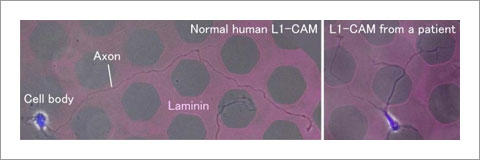Research outcomes
Axons grip and slip their way around the brain
In a new study, NAIST scientists, in collaboration with researchers at the Osaka National Hospital and University of Tokyo, report that the L1 Cell Adhesion Molecule (L1-CAM) is crucial for directed axon migration. The study shows that L1-CAM grips and slips on laminin to steer axons to their final destination. It further explains how disruption of this L1-CAM system leads to CRASH syndrome, which describes an assortment of neural disabilities that are all attributed to an underdeveloped brain. The study can be read (open access) in the Proceedings of the Natural Academy of Sciences of the United States of America (PNAS).
Axons sprout from neurons and then migrate to specific parts of the developing brain where they interact with other neurons to form neural networks. The axons move in response to gradients of attractants with extraordinary sensitivity; the sudden stops and sharp turns they make during their migration resemble cars stopping and turning at an intersection.
"Laminins function as attractive chemical cues for haptotaxis of axonal growth cones," explains NAIST Prof. Naoyuki Inagaki, whose lab studies how forces are generated in the cellular microenvironment to create directed axonal migration.
Axons migrate in response to laminin on the microenvironment. The new study by the Inagaki lab showed that neurons will produce four times more traction force when placed on adhesive substrates coated with laminin than those without laminin, assuring the axons reach their final destination.
"The force reduced the F-actin retrograde flow," said Kouki Abe, a doctoral student in the lab who conducted the experiments. "We looked at the movement of L1-CAM because it is linked to F1-actin flow."
Actin is a crucial molecule for cell motility throughout the body. However, in axons, it does not directly interact with laminin. Rather, L1-CAM acts as the intermediary. As expected, additional experiments by Abe showed that the F1-actin flow was dependent on L1-CAM interactions with laminin.
"We found L1-CAM switches between an immobilized state, or what we call 'grip' state, and a 'slip' state. The ratio of grip state increased with laminin," said Inagaki. This increased grip state strengthens the traction force produced by the axon onto the adhesive substrate, allowing the axon to turn and change its direction on cue. The scientists further found that disrupting the increased grip ratio compromised the directional migration, a discovery that could explain the pathogenesis of several diseases.
"We examined L1-CAM from a patient with CRASH syndrome in which L1-CAM was mutated. The different grip ratio seen between laminin and polylysine was lost, and the directional axon migration was disturbed (Figure)", said Inagaki.
"L1-CAM controls migration not only in the brain, but also in cancer. Grip-and-slip is a new mechanism that could explain other diseases," he said.

Mutation in CRASH syndrome leads to dysfunction of the grip & slip mechanism and disrupts laminin-induced axonal haptotaxis.
Resource
- Title: Grip and slip of L1-CAM on adhesive substrates direct growth cone haptotaxis
- Authors: Kouki Abe, Hiroko Katsuno, Michinori Toriyama, Kentarou Baba, Tomoyuki Mori, Toshio Hakoshima, Yonehiro Kanemura, Rikiya Watanabe, and Naoyuki Inagaki*
- Publication: Proceedings of the National Academy of Sciences of the United States of America
- DOI: 10.1073/pnas.1711667115
- *Author for correspondence
Information about Prof. Inagaki lab can be found at the following website:
http://bsw3.naist.jp/eng/courses/courses204.html
[ Press Release ] February 27, 2018
( March 07, 2018 )
